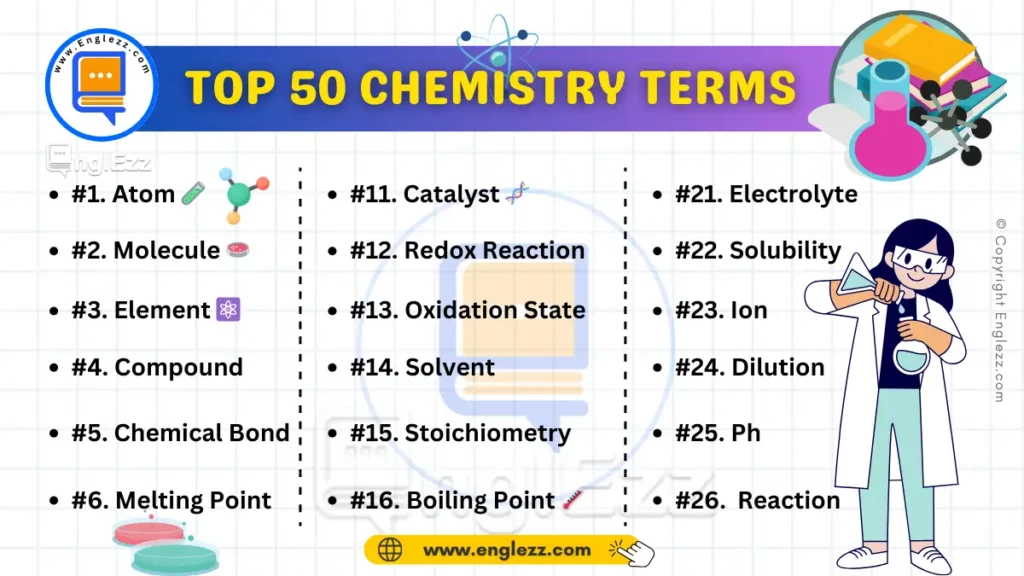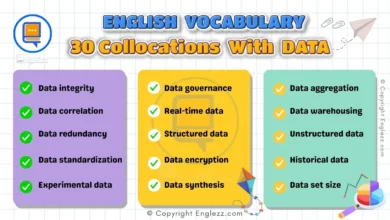Chemistry is a fascinating and complex field that plays a crucial role in our everyday lives, from the food we eat to the products we use. Understanding the terminology used in chemistry can enhance your grasp of the subject and improve your communication about chemical processes. In this blog post, we’ll explore the 50 most common chemistry English terms, each explained with clear definitions, phonetic transcriptions, and practical examples.
Table of Contents
- 50 Most Common Chemistry English Terms Explained with Examples
- #1. Atom 🧪
- #2. Molecule 💧
- #3. Element 🌟
- #4. Compound 🔬
- #5. Chemical Reaction ⚗️
- #6. Bond 💥
- #7. Catalyst ⏳
- #8. Acid 🧪
- #9. Base 🔧
- #10. pH Scale 📉
- #11. Solution 💧
- #12. Solvent 🌊
- #13. Solute 🌡️
- #14. Concentration 📊
- #15. Molarity 📏
- #16. Mole 🧪
- #17. Avogadro’s Number 🔢
- #18. Valence Electrons ⚡
- #19. Ion ⚛️
- #20. Isotope 🌈
- #21. Reaction Rate ⏲️
- #22. Equilibrium ⚖️
- #23. Thermodynamics 🔥
- #24. Entropy 📉
- #25. Enthalpy 🔥
- #26. Catalyst 🧬
- #27. Redox Reaction 🔄
- #28. Oxidation State 🔥
- #29. Equilibrium Constant ⚖️
- #30. Stoichiometry ⚗️
- #31. Law of Conservation of Mass ⚖️
- #32. Ionic Bond ⚡
- #33. Covalent Bond 🔗
- #34. Molecular Weight ⚖️
- #35. Quantum Chemistry ⚛️
- #36. Spectroscopy 🔭
- #37. Chemical Kinetics ⏱️
- #38. Le Chatelier’s Principle ⚖️
- #39. Periodic Table 📅
- #40. Valence Shell 🏠
- #41. Hybridization 🧬
- #42. Thermochemistry 🔥
- #43. Electrolyte ⚡
- #44. Solubility 🌊
- #45. Concentrated Solution 💧
- #46. Dilution 💧
- #47. Boiling Point 🌡️
- #48. Melting Point ⛄
- #49. Vapor Pressure 💨
- #50. Colligative Properties 🧪
- Chemistry English Terms Table
- Conclusion
50 Most Common Chemistry English Terms Explained with Examples
Whether you’re a student, a professional, or simply curious about the world of chemistry, this comprehensive guide will help demystify these essential terms. Dive in to expand your vocabulary and gain a deeper appreciation for the science that shapes our world!
#1. Atom 🧪
Definition: The smallest unit of an element that retains its chemical properties.
Phonetic Transcription: ˈætəm
Examples:
- An atom of hydrogen is the simplest type of atom, consisting of just one proton and one electron.
- Atoms combine to form molecules, such as H₂O (water).
#2. Molecule 💧
Definition: A group of atoms bonded together, representing the smallest unit of a chemical compound that can take part in a chemical reaction.
Phonetic Transcription: ˈmɒlɪkjuːl
Examples:
- Water (H₂O) is a molecule consisting of two hydrogen atoms and one oxygen atom.
- Carbon dioxide (CO₂) is a molecule with one carbon atom and two oxygen atoms.
#3. Element 🌟
Definition: A pure substance consisting only of one type of atom.
Phonetic Transcription: ˈɛlɪmənt
Examples:
- Gold (Au) is an element because it is made up of only gold atoms.
- Oxygen (O₂) is an element and a vital component of the air we breathe.
#4. Compound 🔬
Definition: A substance formed from two or more elements chemically bonded together.
Phonetic Transcription: ˈkəmˌpaʊnd
Examples:
- Sodium chloride (NaCl) is a compound formed from sodium and chlorine elements.
- Carbon dioxide (CO₂) is a compound composed of carbon and oxygen.
#5. Chemical Reaction ⚗️
Definition: A process that leads to the transformation of one set of chemical substances to another.
Phonetic Transcription: ˈkɛmɪkəl rɪˈækʃən
Examples:
- The reaction between baking soda and vinegar produces carbon dioxide gas.
- Photosynthesis in plants converts carbon dioxide and water into glucose and oxygen.
#6. Bond 💥
Definition: The force that holds atoms together in a molecule.
Phonetic Transcription: bɒnd
Examples:
- Covalent bonds involve the sharing of electrons between atoms.
- Ionic bonds occur when electrons are transferred from one atom to another.
#7. Catalyst ⏳
Definition: A substance that speeds up a chemical reaction without being consumed in the process.
Phonetic Transcription: ˈkætəlɪst
Examples:
- Enzymes in biological systems act as catalysts to accelerate metabolic reactions.
- Platinum is used as a catalyst in catalytic converters to reduce vehicle emissions.
#8. Acid 🧪
Definition: A substance that donates hydrogen ions (H⁺) and has a pH less than 7.
Phonetic Transcription: ˈæsɪd
Examples:
- Hydrochloric acid (HCl) is a strong acid found in the stomach.
- Citric acid, found in lemons, gives them their sour taste.
#9. Base 🔧
Definition: A substance that accepts hydrogen ions (H⁺) or donates hydroxide ions (OH⁻) and has a pH greater than 7.
Phonetic Transcription: beɪs
Examples:
- Sodium hydroxide (NaOH) is a strong base used in cleaning products.
- Ammonia (NH₃) acts as a base in many household cleaning solutions.
#10. pH Scale 📉
Definition: A scale used to measure the acidity or basicity of a solution.
Phonetic Transcription: piː eɪtʃ skeɪl
Examples:
- The pH of pure water is 7, which is neutral.
- Lemon juice has a pH around 2, indicating its acidic nature.

#11. Solution 💧
Definition: A homogeneous mixture of two or more substances.
Phonetic Transcription: səˈluːʃən
Examples:
- Saltwater is a solution of salt dissolved in water.
- Sugar dissolved in tea creates a sweet solution.
#12. Solvent 🌊
Definition: A substance that dissolves a solute to form a solution.
Phonetic Transcription: ˈsɒlvənt
Examples:
- Water is known as the universal solvent because it dissolves many substances.
- Ethanol is used as a solvent in various chemical processes and solutions.
#13. Solute 🌡️
Definition: A substance that is dissolved in a solvent to form a solution.
Phonetic Transcription: ˈsɒljuːt
Examples:
- Table salt (sodium chloride) is a solute when dissolved in water.
- Sugar is a solute when mixed with tea or coffee.
#14. Concentration 📊
Definition: The amount of a substance in a given volume of solution.
Phonetic Transcription: ˌkɒnsənˈtreɪʃən
Examples:
- A concentrated solution of hydrochloric acid contains a high amount of HCl.
- Diluting orange juice with water reduces its concentration of juice.
#15. Molarity 📏
Definition: The concentration of a solution expressed in moles of solute per liter of solution.
Phonetic Transcription: məʊˈlærɪti
Examples:
- A 1 M (molar) solution of sodium chloride contains 1 mole of NaCl per liter of solution.
- Molarity helps in preparing solutions with precise concentrations for reactions.
#16. Mole 🧪
Definition: A unit in chemistry that represents 6.022 x 10²³ particles of a substance.
Phonetic Transcription: moʊl
Examples:
- One mole of carbon contains 6.022 x 10²³ carbon atoms.
- The mole concept helps chemists quantify amounts of substances in reactions.
#17. Avogadro’s Number 🔢
Definition: The number of particles in one mole of a substance, approximately 6.022 x 10²³.
Phonetic Transcription: ˌævəˈɡɑːdroʊz ˈnʌmbər
Examples:
- Avogadro’s number is used to calculate the number of molecules in a mole of a substance.
- This number is fundamental in converting between moles and number of particles.
#18. Valence Electrons ⚡
Definition: Electrons in the outermost shell of an atom, involved in forming bonds.
Phonetic Transcription: ˈveɪləns ɪˈlɛktrɒnz
Examples:
- The valence electrons of carbon (4) are involved in forming covalent bonds with other atoms.
- Sodium has one valence electron, which it donates to form bonds in ionic compounds.
#19. Ion ⚛️
Definition: An atom or molecule that has gained or lost one or more electrons, resulting in a charged species.
Phonetic Transcription: ˈaɪɒn
Examples:
- Sodium ions (Na⁺) are positively charged ions formed when sodium loses an electron.
- Chloride ions (Cl⁻) are negatively charged ions formed when chlorine gains an electron.
#20. Isotope 🌈
Definition: Variants of a chemical element that have the same number of protons but different numbers of neutrons.
Phonetic Transcription: ˈaɪsəˌtoʊp
Examples:
- Carbon-12 and Carbon-14 are isotopes of carbon with different numbers of neutrons.
- Isotopes are used in dating archaeological finds and medical imaging.
#21. Reaction Rate ⏲️
Definition: The speed at which a chemical reaction occurs.
Phonetic Transcription: rɪˈækʃən reɪt
Examples:
- The reaction rate can be increased by adding a catalyst to a reaction.
- Temperature changes can affect the rate at which a reaction proceeds.
#22. Equilibrium ⚖️
Definition: A state in which the forward and reverse reactions occur at the same rate, so the concentrations of reactants and products remain constant.
Phonetic Transcription: ˌiːkwɪˈlɪbrɪəm
Examples:
- In a reversible reaction, equilibrium is reached when the rates of both directions are equal.
- Chemical equilibrium can be disturbed by changing concentration, temperature, or pressure.
#23. Thermodynamics 🔥
Definition: The branch of chemistry that deals with the relationships between heat and other forms of energy.
Phonetic Transcription: ˌθɜːrməʊdaɪˈnæmɪks
Examples:
- Thermodynamics explains how energy is transferred in chemical reactions.
- It helps in understanding processes like combustion and refrigeration.
#24. Entropy 📉
Definition: A measure of the disorder or randomness in a system.
Phonetic Transcription: ˈɛntrəpi
Examples:
- Entropy increases in the melting of ice into water, where the disorder of molecules increases.
- Chemical reactions often result in an increase in entropy as products are more disordered than reactants.
#25. Enthalpy 🔥
Definition: The total heat content of a system, used to measure the heat absorbed or released during a reaction.
Phonetic Transcription: ˈɛnθəlpi
Examples:
- The enthalpy change during a reaction can be measured to determine whether it is exothermic or endothermic.
- The heat released when burning a fuel is an example of enthalpy change.
#26. Catalyst 🧬
Definition: A substance that increases the rate of a chemical reaction without being consumed.
Phonetic Transcription: ˈkætəlɪst
Examples:
- Enzymes in the human body act as biological catalysts, speeding up metabolic reactions.
- Platinum catalysts are used in automobile catalytic converters to reduce emissions.
#27. Redox Reaction 🔄
Definition: A type of reaction where oxidation and reduction occur simultaneously.
Phonetic Transcription: ˈriːdɒks rɪˈækʃən
Examples:
- In the rusting of iron, iron is oxidized and oxygen is reduced.
- The process of cellular respiration involves redox reactions to produce energy.
#28. Oxidation State 🔥
Definition: The charge of an atom in a compound, representing its degree of oxidation.
Phonetic Transcription: ˌɒksɪˈdeɪʃən steɪt
Examples:
- In water (H₂O), oxygen has an oxidation state of -2.
- The oxidation state of iron in rust (Fe₂O₃) is +3.
#29. Equilibrium Constant ⚖️
Definition: A number that expresses the ratio of the concentrations of products to reactants at equilibrium.
Phonetic Transcription: ˌiːkwɪˈlɪbrɪəm ˈkɒnstənt
Examples:
- The equilibrium constant (K) helps in predicting the extent of a reaction.
- A large K value indicates that the reaction favors the formation of products.
#30. Stoichiometry ⚗️
Definition: The calculation of reactants and products in chemical reactions.
Phonetic Transcription: ˌstɔɪkiˈɒmɪtri
Examples:
- Stoichiometry is used to determine how much of a reactant is needed to produce a given amount of product.
- It helps in balancing chemical equations to reflect the correct proportions of reactants and products.
#31. Law of Conservation of Mass ⚖️
Definition: A principle stating that mass is neither created nor destroyed in a chemical reaction.
Phonetic Transcription: lɔː ɒv kənˌsɜːveɪʃən ɒv mæs
Examples:
- In a closed system, the total mass of reactants equals the total mass of products.
- This law is fundamental in balancing chemical equations.
#32. Ionic Bond ⚡
Definition: A type of chemical bond formed through the electrostatic attraction between oppositely charged ions.
Phonetic Transcription: aɪˈɒnɪk bɒnd
Examples:
- Sodium chloride (NaCl) is formed by ionic bonds between sodium (Na⁺) and chloride (Cl⁻) ions.
- Magnesium oxide (MgO) has ionic bonds between magnesium (Mg²⁺) and oxygen (O²⁻) ions.
#33. Covalent Bond 🔗
Definition: A type of chemical bond where atoms share pairs of electrons.
Phonetic Transcription: kəʊˈveɪlənt bɒnd
Examples:
- In a water molecule (H₂O), oxygen and hydrogen atoms are connected by covalent bonds.
- Carbon dioxide (CO₂) has covalent bonds between carbon and oxygen atoms.
#34. Molecular Weight ⚖️
Definition: The sum of the atomic weights of all atoms in a molecule.
Phonetic Transcription: məˈlɛkjʊlər weɪt
Examples:
- The molecular weight of water (H₂O) is 18.02 g/mol.
- Calculating molecular weight helps in determining the amounts of substances needed in reactions.
#35. Quantum Chemistry ⚛️
Definition: The study of the physical properties of molecules using quantum mechanics.
Phonetic Transcription: ˈkwɒntəm ˈkɛmɪstri
Examples:
- Quantum chemistry explains the electronic structure of atoms and molecules.
- It helps predict chemical bonding and reactions at the quantum level.
#36. Spectroscopy 🔭
Definition: A technique used to measure the interaction of light with matter to identify substances.
Phonetic Transcription: spɛkˈtrɒskəpi
Examples:
- UV-Vis spectroscopy is used to analyze the absorbance of ultraviolet and visible light by a sample.
- Nuclear magnetic resonance (NMR) spectroscopy provides information about molecular structure.
#37. Chemical Kinetics ⏱️
Definition: The study of the rates of chemical reactions and the factors affecting them.
Phonetic Transcription: ˈkɛmɪkəl kɪˈnɛtɪks
Examples:
- Chemical kinetics helps in understanding how catalysts affect reaction rates.
- The rate of a reaction can be influenced by temperature, concentration, and pressure.
#38. Le Chatelier’s Principle ⚖️
Definition: A principle stating that if a dynamic equilibrium is disturbed, the system will adjust to counteract the disturbance.
Phonetic Transcription: lə ʃætəˈljeɪz ˈprɪnsəpəl
Examples:
- Adding more reactant to a reaction at equilibrium shifts the balance towards the products.
- Increasing temperature in an exothermic reaction will shift the equilibrium to favor the reactants.
#39. Periodic Table 📅
Definition: A tabular arrangement of chemical elements based on their atomic number, electron configuration, and recurring chemical properties.
Phonetic Transcription: ˌpɪərɪˈɒdɪk ˈteɪbl
Examples:
- The periodic table organizes elements into groups and periods, reflecting their chemical behavior.
- Elements in the same group, such as the noble gases, share similar properties.
#40. Valence Shell 🏠
Definition: The outermost electron shell of an atom, which determines its chemical bonding behavior.
Phonetic Transcription: ˈveɪləns ʃɛl
Examples:
- The valence shell of an atom dictates how it bonds with other atoms to form molecules.
- Elements with full valence shells, like the noble gases, are generally inert.
#41. Hybridization 🧬
Definition: The mixing of atomic orbitals to form new hybrid orbitals that can form covalent bonds.
Phonetic Transcription: ˌhaɪbrɪdaɪˈzeɪʃən
Examples:
- sp³ hybridization occurs in methane (CH₄), where carbon forms four equivalent bonds.
- sp² hybridization is found in ethene (C₂H₄), where carbon forms a double bond with another carbon.
#42. Thermochemistry 🔥
Definition: The study of the heat involved in chemical reactions.
Phonetic Transcription: ˌθɜːrməʊˈkɛmɪstri
Examples:
- Thermochemistry helps in understanding endothermic and exothermic reactions.
- It measures the heat changes during combustion reactions.
#43. Electrolyte ⚡
Definition: A substance that conducts electricity when dissolved in water or melted.
Phonetic Transcription: ɪˈlɛktrəˌlaɪt
Examples:
- Sodium chloride (NaCl) is an electrolyte that dissociates into ions in solution.
- Electrolytes are essential for conducting electrical signals in biological systems.
#44. Solubility 🌊
Definition: The ability of a substance to dissolve in a solvent to form a homogeneous solution.
Phonetic Transcription: ˌsɒljʊˈbɪləti
Examples:
- Salt has high solubility in water, dissolving easily to form a saline solution.
- Oil has low solubility in water, resulting in a separation from the aqueous phase.
#45. Concentrated Solution 💧
Definition: A solution that contains a large amount of solute relative to the solvent.
Phonetic Transcription: ˈkɒnsənˌtreɪtɪd səˈluːʃən
Examples:
- A concentrated sulfuric acid solution has a high amount of sulfuric acid relative to water.
- Concentrated bleach contains a high concentration of sodium hypochlorite.
#46. Dilution 💧
Definition: The process of reducing the concentration of a solute in a solution, typically by adding more solvent.
Phonetic Transcription: daɪˈluːʃən
Examples:
- Diluting hydrochloric acid with water reduces its concentration.
- A dilute solution of saltwater has less salt compared to a concentrated solution.
#47. Boiling Point 🌡️
Definition: The temperature at which a liquid turns into vapor.
Phonetic Transcription: ˈbɔɪlɪŋ pɔɪnt
Examples:
- The boiling point of water is 100°C (212°F) at standard atmospheric pressure.
- The boiling point of ethanol is 78.37°C (173.1°F), lower than that of water.
#48. Melting Point ⛄
Definition: The temperature at which a solid turns into a liquid.
Phonetic Transcription: ˈmɛltɪŋ pɔɪnt
Examples:
- Ice melts at 0°C (32°F), turning from solid to liquid water.
- The melting point of gold is 1,064°C (1,947°F).
#49. Vapor Pressure 💨
Definition: The pressure exerted by a vapor in equilibrium with its liquid or solid phase.
Phonetic Transcription: ˈveɪpər ˈprɛʃər
Examples:
- The vapor pressure of water increases with temperature, leading to boiling.
- High vapor pressure indicates that a substance evaporates easily.
#50. Colligative Properties 🧪
Definition: Properties of solutions that depend on the number of solute particles but not their identity.
Phonetic Transcription: kəˈlɪɡətɪv ˈprɒpərtiːz
Examples:
- Boiling point elevation and freezing point depression are colligative properties.
- Adding salt to water increases its boiling point and lowers its freezing point.
Chemistry English Terms Table
| #1. Atom 🧪 | #11. Catalyst 🧬 | #21. Electrolyte ⚡ |
| #2. Molecule 🧫 | #12. Redox Reaction 🔄 | #22. Solubility 🌊 |
| #3. Element ⚛️ | #13. Oxidation State 🔥 | #23. Concentrated Solution 💧 |
| #4. Compound 🔗 | #14. Equilibrium Constant ⚖️ | #24. Dilution 💧 |
| #5. Chemical Bond 🔗 | #15. Stoichiometry ⚗️ | #25. Boiling Point 🌡️ |
| #6. Reaction ⚡ | #16. Law of Conservation of Mass ⚖️ | #26. Melting Point ⛄ |
| #7. Ion ⚡ | #17. Ionic Bond ⚡ | #27. Vapor Pressure 💨 |
| #8. pH 🌡️ | #18. Covalent Bond 🔗 | #28. Colligative Properties 🧪 |
| #9. Solution 🌊 | #19. Molecular Weight ⚖️ | #29. Quantum Chemistry ⚛️ |
| #10. Solvent 💧 | #20. Spectroscopy 🔭 | #30. Thermochemistry 🔥 |
Conclusion
Understanding the terminology of chemistry is fundamental for mastering the subject and applying its principles effectively. From basic concepts like atoms and molecules to more complex ideas like thermodynamics and colligative properties, each term plays a vital role in the study and application of chemistry.
By familiarizing yourself with these 50 common chemistry terms, you’ll be better equipped to navigate the world of chemical reactions, laboratory practices, and scientific discussions.
We hope this guide serves as a valuable resource in your chemistry journey. For more educational content and updates, follow @EnglEzz and stay tuned for our next post!









Dive into the essential world of chemistry with our guide on the 50 Most Common Chemistry Terms! Whether you’re a student or a science enthusiast, understanding these key concepts will enhance your chemistry knowledge and application.
Explore definitions, examples, and more to boost your learning. Follow and like @EnglEzz for more educational content! 🌟 Check out the full post here:
.
https://www.englezz.com/most-common-chemistry-english-terms/
.
#englezz #vocabulary #linguistics #chemistry #science #education #learn #students #academic